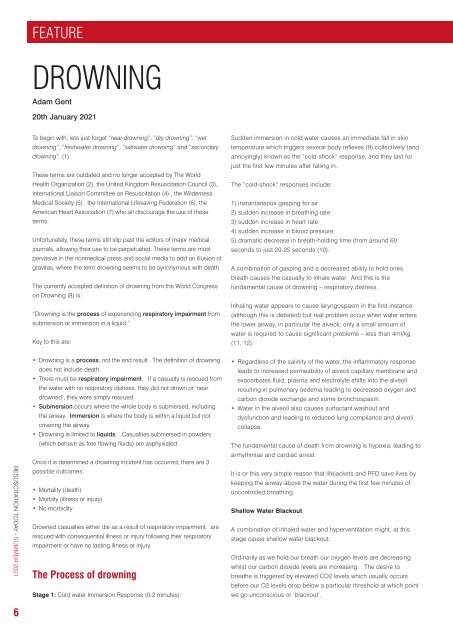Resus Today Summer 2021
Resus Today Summer 2021
Resus Today Summer 2021
You also want an ePaper? Increase the reach of your titles
YUMPU automatically turns print PDFs into web optimized ePapers that Google loves.
FEATURE<br />
DROWNING<br />
Adam Gent<br />
20th January <strong>2021</strong><br />
To begin with, lets just forget “near-drowning”, “dry drowning”, “wet<br />
drowning”, “freshwater drowning”, “saltwater drowning” and “secondary<br />
drowning”. (1)<br />
These terms are outdated and no longer accepted by The World<br />
Health Organization (2), the United Kingdom <strong>Resus</strong>citation Council (3),<br />
International Liaison Committee on <strong>Resus</strong>citation (4) , the Wilderness<br />
Medical Society (5) , the International Lifesaving Federation (6), the<br />
American Heart Association (7) who all discourage the use of these<br />
terms.<br />
Unfortunately, these terms still slip past the editors of major medical<br />
journals, allowing their use to be perpetuated. These terms are most<br />
pervasive in the nonmedical press and social media to add an illusion of<br />
gravitas, where the term drowning seems to be synonymous with death.<br />
The currently accepted definition of drowning from the World Congress<br />
on Drowning (8) is:<br />
“Drowning is the process of experiencing respiratory impairment from<br />
submersion or immersion in a liquid.”<br />
Key to this are:<br />
Sudden immersion in cold water causes an immediate fall in skin<br />
temperature which triggers several body reflexes (9) collectively (and<br />
annoyingly) known as the “cold-shock” response, and they last for<br />
just the first few minutes after falling in.<br />
The “cold-shock” responses include:<br />
1) instantaneous gasping for air<br />
2) sudden increase in breathing rate<br />
3) sudden increase in heart rate<br />
4) sudden increase in blood pressure<br />
5) dramatic decrease in breath-holding time (from around 60<br />
seconds to just 20-25 seconds (10).<br />
A combination of gasping and a decreased ability to hold ones<br />
breath causes the casualty to inhale water. And this is the<br />
fundamental cause of drowning – respiratory distress.<br />
Inhaling water appears to cause laryngospasm in the first instance<br />
(although this is debated) but real problem occur when water enters<br />
the lower airway, in particular the alveoli; only a small amount of<br />
water is required to cause significant problems – less than 4ml/kg<br />
(11, 12).<br />
RESUSCITATION TODAY - SUMMER <strong>2021</strong><br />
• Drowning is a process, not the end result. The definition of drowning<br />
does not include death.<br />
• There must be respiratory impairment. If a casualty is rescued from<br />
the water with no respiratory distress, they did not drown or ‘near<br />
drowned’, they were simply rescued.<br />
• Submersion occurs where the whole body is submersed, including<br />
the airway. Immersion is where the body is within a liquid but not<br />
covering the airway.<br />
• Drowning is limited to liquids. Casualties submersed in powders<br />
(which behave as free flowing fluids) are asphyxiated.<br />
Once it is determined a drowning incident has occurred, there are 3<br />
possible outcomes:<br />
• Mortality (death)<br />
• Morbity (illness or injury)<br />
• No morbidity<br />
Drowned casualties either die as a result of respiratory impairment, are<br />
rescued with consequential illness or injury following their respiratory<br />
impairment or have no lasting illness or injury.<br />
The Process of drowning<br />
Stage 1: Cold water Immersion Response (0-2 minutes):<br />
• Regardless of the salinity of the water, the inflammatory response<br />
leads to increased permeability of alveoli capillary membrane and<br />
exacerbates fluid, plasma and electrolyte shifts into the alveoli<br />
resulting in pulmonary oedema leading to decreased oxygen and<br />
carbon dioxide exchange and some bronchospasm.<br />
• Water in the alveoli also causes surfactant washout and<br />
dysfunction and leading to reduced lung compliance and alveoli<br />
collapse.<br />
The fundamental cause of death from drowning is hypoxia, leading to<br />
arrhythmias and cardiac arrest.<br />
It is or this very simple reason that lifejackets and PFD save lives by<br />
keeping the airway above the water during the first few minutes of<br />
uncontrolled breathing.<br />
Shallow Water Blackout<br />
A combination of inhaled water and hyperventilation might, at this<br />
stage cause shallow water blackout:<br />
Ordinarily as we hold our breath our oxygen levels are decreasing<br />
whilst our carbon dioxide levels are increasing. The desire to<br />
breathe is triggered by elevated CO2 levels which usually occurs<br />
before our O2 levels drop below a particular threshold at which point<br />
we go unconscious or ‘blackout’.<br />
6

















